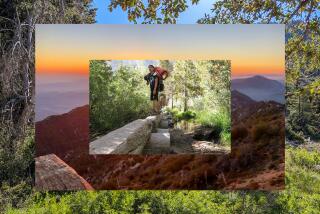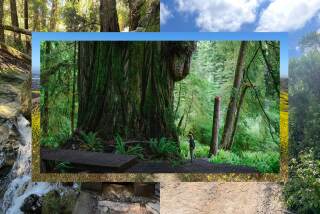More Campsites and Trails Proposed for Santa Cruz Island
Catering to those seeking a more isolated wilderness experience, Channel Islands National Park hopes to expand the length and number of trails on Santa Cruz Island while building several remote campsites in the back country.
The proposal, put forward by park Supt. Tim Setnicka, is part of a plan to attract more visitors to Santa Cruz, the largest of the Channel islands. The park service controls about 25% of the 62,000-acre island, while the Nature Conservancy owns the rest.
Setnicka wants to create an 18-mile loop trail from existing roads and trails on the isthmus section of the island. The trail would begin and end at Prisoner’s Harbor.
The proposal also calls for four primitive campgrounds offering alternatives to the two often-crowded campgrounds on the island.
“Every national park has some sort of option for backcountry campers,” said Tom Dore, park spokesman. “This plan gives people who want isolation and to be truly alone in a secluded natural setting the chance to have that experience.”
Dore said campsites on all the islands suffer from close proximity to one another, and those on Santa Cruz can get up to 250 people at a time. The new proposal would set up sites along the 14-mile hike between Scorpion and Prisoner’s harbors, giving trekkers a place to spend the night during the journey.
The east end of Santa Cruz was chosen for expanded hiking because the island isn’t as ecologically fragile as other islands in the chain, such as Anacapa, Santa Rosa and Santa Barbara.
“Human impact will show least in a place so devastated by feral sheep and pigs,” Dore said. “If there is a problem, we can stop it at any time.”
Santa Cruz averages between 22,000 and 26,000 visitors a year, compared with 99,000 last year at Anacapa, Dore said.
An environmental assessment of the proposal is available for public review until Sept. 6. Officials say trails and campgrounds could affect some historic and archeological sites on the island. There is also a danger that hikers could bring in nonnative seeds on shoes and clothing that could sprout and cause damage, like the fennel that continues to plague the island.
If the plan is approved, the trail and campsites could be completed as early as next spring, Dore said.
More to Read
Sign up for The Wild
We’ll help you find the best places to hike, bike and run, as well as the perfect silent spots for meditation and yoga.
You may occasionally receive promotional content from the Los Angeles Times.






